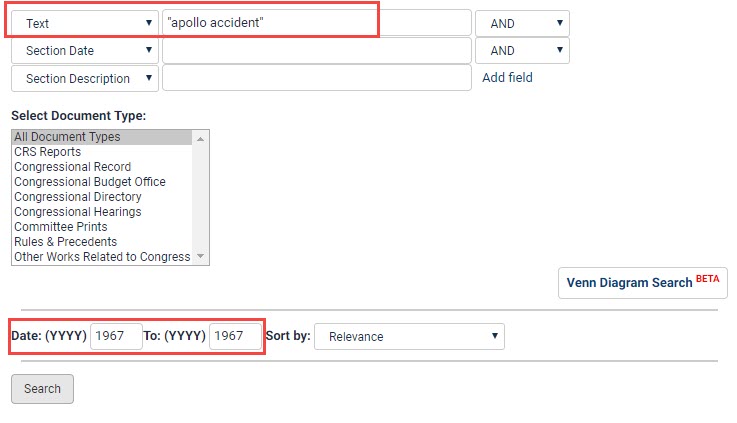Just 66 years after Orville and Wilbur Wright took mankind to the air, the United States put a man on the moon. Tomorrow, the fiftieth anniversary of that first moon landing will be commemorated across the United States. Most U.S. citizens can tell you that Neil Armstrong was the first man to step foot on the moon, but fewer may understand the journey it took to get there. Launch into a history of the Space Race and the evolution of the Apollo program with HeinOnline.
Before We Get Started:
Don’t miss out! Make sure you have the databases we’ll be mentioning in this post. Follow the links below to start a trial today.
- U.S. Presidential Library
- U.S. Federal Legislative History Library
- U.S. Statutes at Large
- U.S. Congressional Serial Set
- U.S. Congressional Documents
The 20th Century Space Race
In the mid-20th century, profound political and economic differences between the Soviet Union (USSR) and United States drove the two countries into a Cold War—a war characterized by hostile measures other than military action. For nearly half a century, the two superpowers struggled for dominance through the use of propaganda campaigns, trade barriers, psychological warfare, proxy wars, espionage, and technological competition. In the name of national security, the United States and USSR turned their sights to nuclear technology and spaceflight as top priorities, sometimes with devastating consequences.
To the surprise (and fear) of people around the globe, in 1957 the Soviet Union launched the first-ever artificial satellite, Sputnik, signaling to onlookers that the USSR was a military, economic, and technological force to be reckoned with. In response to this perceived threat to American technological superiority, U.S. President Dwight D. Eisenhower signed the 1958 National Aeronautics and Space Act to establish the National Aeronautics and Space Administration (NASA). In the same year, NASA initiated Project Mercury, the first U.S. human spaceflight program. Users can find the National Aeronautics and Space Act of 1958 in HeinOnline’s U.S. Statutes at Large. In addition, view the act’s legislative history in HeinOnline’s U.S. Federal Legislative History Library.
On April 12, 1961, the Soviet Union again beat the United States to a spaceflight milestone by successfully sending the first human being into space. Just under a month later, Alan Shepard became the first American to travel to space as a part of NASA’s second human spaceflight program, Project Gemini. To congratulate Shepard on this achievement, President John F. Kennedy presented him with NASA’s Distinguished Service Medal.
To match the Soviet Union’s achievements, Kennedy was determined to come up with a challenge in space technology that the United States actually stood a chance to win. Addressing the United States Congress on “Urgent National Needs” on May 25, 1961, Kennedy proposed that America focus its efforts on putting a man on the moon. Though not necessarily beneficial in terms of economic or military power, the success of such a project would help the United States regain the leading edge in technological advancement. View Kennedy’s speech in the Public Papers of the President in HeinOnline’s U.S. Presidential Library. Select Kennedy’s name, the correct year, and scroll through the electronic table of contents to view papers from the month of May. Users will find the speech under “Special Message to Congress on Urgent National Needs.”

An Overview of the Apollo Program
To fulfill Kennedy’s goal of landing a man on the moon, NASA established its third human spaceflight program, Project Apollo. The first five years of the project were dedicated to testing various components of the Apollo spacecraft in unmanned missions. A total of eight unmanned tests launched before the first crewed mission in 1967.
The Apollo 1 Fire
Initially known as AS-204, Apollo 1 was the first planned crewed mission of the Apollo program. Though scheduled for February 21, 1967, the mission never launched. A cabin fire during a rehearsal test on January 27 destroyed the command module and killed all three crew members—Command Pilot Virgil I. Grissom, Senior Pilot Ed White, and Pilot Roger B. Chaffee. To determine the cause of the fire, NASA established the Apollo 204 Accident Review Board. The 90th U.S. Congress initiated its own committee within both houses to oversee the investigation. Users can view the initial report to Congress on the accident in HeinOnline’s U.S. Congressional Serial Set.
Furthermore, users may view the final report of the Apollo 204 Review Board before Congress in HeinOnline’s U.S. Congressional Documents. From within the database, select the Advanced Search option hyperlinked in blue under the main search bar. Entering relevant descriptors and a limited date range, as below, will yield the Apollo 204 Review Board’s final report as the only result.

Apollo Missions 4-10
The first flight after the Apollo 1 fire was another unmanned mission to test Saturn V, the largest launch vehicle to ever attempt flight at the time. Known as Apollo 4, the mission lasted nine hours and was deemed a complete success. The next two missions were also unmanned and considered successes. Apollo 5 tested the descent and ascent engines in a space environment and simulated a landing abort. Apollo 6 identified problems that, once fixed, allowed NASA to declare the Saturn V vehicle man-rated, or capable of safely transporting humans.
In October of 1968, Apollo 7 became the first crewed mission of the Apollo program, lasting for 11 days. Apollo 7 fulfilled the original goal of Apollo 1, to test the command and service module (CSM) systems in low Earth orbit. Two months later, the Apollo 8 mission left low Earth orbit, reached the moon, and returned. The crew of Apollo 8 thus were the first humans to see and photograph an “Earthrise”.
Until 1969, components of the Apollo spacecraft had been tested separately. In March of 1969, however, Apollo 9 became the first mission to fly the full Apollo spacecraft, albeit in low Earth orbit once again. The Apollo 10 mission in May of the same year took the full spacecraft out of low Earth orbit and reached the moon, but did not land. Users can read a discussion in Congress about the success of these four manned Apollo missions in HeinOnline’s U.S. Congressional Documents database.
The Apollo 11 Mission and Beyond
After launching on July 16, 1969, the Apollo 11 mission traveled 240,000 miles from Earth to the moon in 76 hours. The crew consisted of Commander Neil Armstrong, lunar module pilot Buzz Aldrin, and command module pilot Michael Collins. On July 20, approximately 600 million people watched as Neil Armstrong became the first person to step foot on the moon. Shortly after, Buzz Aldrin joined Armstrong on the surface. Immediately upon landing, Armstrong gathered a small sample of lunar material and put it in his pocket, in case an emergency barred them from transporting more later on. Aldrin and Armstrong then went on to plant the flag of the United States in the moon’s surface. Just before they could take a photo with the flag, the astronauts received a historic telephone-radio transmission from President Richard Nixon. Users can read a transcript of Nixon’s telephone conversation with the Apollo 11 astronauts in the Public Papers of the Presidents in HeinOnline’s U.S. Presidential Library. The success of the Apollo 11 mission fulfilled President Kennedy’s goal from 1961 and effectively ended the Space Race.
Following Apollo 11, NASA continued to refine the Apollo launch vehicle and spacecraft as well as test the capability of astronauts in extended stays in space. After 1969, five more Apollo missions successfully landed on the moon. The last men to walk on the moon did so in 1972 as a part of the Apollo 17 mission.
Space Exploration Since Apollo
Since the beginning of the Space Race, more than 560 people have traveled to space from nearly 40 countries. However, since Apollo 17, none have left the Earth’s orbit. In 1971, the Soviet Union launched the world’s first space station. In 1976, the United States performed the first successful landing of a spacecraft on Mars and subsequently received the first successful photos and soil samples from its surface.
In 1977, NASA launched the Voyager program to send two probes to study the solar system. In 1981, NASA’s fourth human spaceflight project, the Space Shuttle program, created the first reusable spacecraft with the space shuttle Columbia. Between 1986 and 2011, NASA’s space shuttle fleet flew 135 missions, famously launching the Hubble Space Telescope in 1990 and the International Space Station in 1998.
Throughout the 1980s, the Voyager probes became the first spacecraft to fly by Jupiter (1979), Saturn (1980), Uranus (1986), and Neptune (1989). In 2013, Voyager 1 became the first object of human origin to enter interstellar space, traveling further than any known object in history. Voyager 2 joined Voyager 1 in interstellar space just in December of last year.
Do you enjoy learning about highlights in history? Are you eager to catch up on current events? Perhaps you’d rather dive into fun, random subjects like Star Wars, drones, turtles, or circus elephants? The HeinOnline Blog posts about these topics and more. Hit the Subscribe button to stay in the loop.
Don’t forget to connect with HeinOnline on our social media platform: Facebook, Twitter, Instagram, and YouTube.



